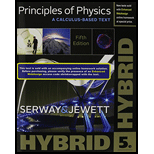
(a)
Whether the statement is true or not for an electron.
(a)
Answer to Problem 1OQ
True.
Explanation of Solution
In 1905 it was Einstein who suggested the concept of light having a wave particle duality. In a similar way Louise de Broglie suggested that electron also exhibits a dual nature.
Broglie derived a mathematical expression to prove the wave nature of electron along with the particle nature by the given expression,
Here,
Conclusion:
Therefore, the given statement is true for electron.
(b)
Whether the rest energy is zero.
(b)
Answer to Problem 1OQ
The statement is False.
Explanation of Solution
The expression for the rest mass energy is given by,
Here,
For the electron,
Conclusion:
Therefore, the rest mass energy of the electron will not be zero, the statement is False.
(c)
Whether it carries energy in its motion.
(c)
Answer to Problem 1OQ
The statement is true.
Explanation of Solution
Electrons in atoms can act as charge carriers. It carries energy in its motion. For a moving electron it will have a velocity along with the mass. For a moving particle it possess kinetic energy. Thus while moving electron also possess energy.
Conclusion:
Therefore, the statement is true.
(d)
Whether the electron carries momentum in its motion.
(d)
Answer to Problem 1OQ
The given statement is true.
Explanation of Solution
Write the expression for the momentum of a particle.
Here,
Electron possess a mass along with velocity in a motion. Thus electron will have momentum.
Conclusion:
Therefore, electron carries momentum in its motion so the given statement is true.
(e)
Whether the motion of the electron is described by a wave function that has a wavelength and satisfies a wave equation.
(e)
Answer to Problem 1OQ
The given statement is true.
Explanation of Solution
Electron exhibits both wave and particle nature. Its motion is described by a wave function that has a wavelength and satisfies a wave function. Equation (I) shows that electron have dual nature.
Conclusion:
Therefore, the given statement motion of the electron is described by a wave function that has a wavelength and satisfies a wave equation is true.
Want to see more full solutions like this?
Chapter 28 Solutions
Principles of Physics: A Calculus-Based Text, Hybrid (with Enhanced WebAssign Printed Access Card)
- An object is placed 24.1 cm to the left of a diverging lens (f = -6.51 cm). A concave mirror (f= 14.8 cm) is placed 30.2 cm to the right of the lens to form an image of the first image formed by the lens. Find the final image distance, measured relative to the mirror. (b) Is the final image real or virtual? (c) Is the final image upright or inverted with respect to the original object?arrow_forwardConcept Simulation 26.4 provides the option of exploring the ray diagram that applies to this problem. The distance between an object and its image formed by a diverging lens is 5.90 cm. The focal length of the lens is -2.60 cm. Find (a) the image distance and (b) the object distance.arrow_forwardPls help ASAParrow_forward
 Principles of Physics: A Calculus-Based TextPhysicsISBN:9781133104261Author:Raymond A. Serway, John W. JewettPublisher:Cengage Learning
Principles of Physics: A Calculus-Based TextPhysicsISBN:9781133104261Author:Raymond A. Serway, John W. JewettPublisher:Cengage Learning University Physics Volume 3PhysicsISBN:9781938168185Author:William Moebs, Jeff SannyPublisher:OpenStax
University Physics Volume 3PhysicsISBN:9781938168185Author:William Moebs, Jeff SannyPublisher:OpenStax Modern PhysicsPhysicsISBN:9781111794378Author:Raymond A. Serway, Clement J. Moses, Curt A. MoyerPublisher:Cengage Learning
Modern PhysicsPhysicsISBN:9781111794378Author:Raymond A. Serway, Clement J. Moses, Curt A. MoyerPublisher:Cengage Learning Physics for Scientists and Engineers with Modern ...PhysicsISBN:9781337553292Author:Raymond A. Serway, John W. JewettPublisher:Cengage Learning
Physics for Scientists and Engineers with Modern ...PhysicsISBN:9781337553292Author:Raymond A. Serway, John W. JewettPublisher:Cengage Learning Physics for Scientists and Engineers: Foundations...PhysicsISBN:9781133939146Author:Katz, Debora M.Publisher:Cengage Learning
Physics for Scientists and Engineers: Foundations...PhysicsISBN:9781133939146Author:Katz, Debora M.Publisher:Cengage Learning




